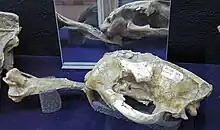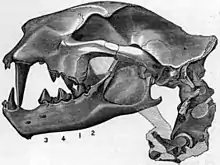Nimravus
Nimravus is an extinct genus of "false" saber-toothed cat in the family Nimravidae known from North America and Europe during the Oligocene epoch 33.3—26.3 mya, existing for approximately 7 million years. Not closely related to true saber-toothed cats, they evolved a similar form through parallel evolution. Fossils have been uncovered in the western U.S. from Oregon to southern California and Nebraska.

| Nimravus Temporal range: Oligocene, | |
|---|---|
 | |
| N. brachyops skull | |
| Scientific classification | |
| Domain: | Eukaryota |
| Kingdom: | Animalia |
| Phylum: | Chordata |
| Class: | Mammalia |
| Order: | Carnivora |
| Suborder: | Feliformia |
| Family: | †Nimravidae |
| Subfamily: | †Nimravinae |
| Genus: | †Nimravus Cope, 1879 |
| Type species | |
| †Nimravus brachyops Cope, 1879 | |
| Species | |
| |
Description
Nimravus was around 1.2 metres (4 ft) in body length. With its sleek body, it may have resembled the modern caracal, although it had a longer back and more dog-like feet with partially retractile claws. It probably hunted birds and small mammals, ambushing them like modern cats, rather than chasing them down. Nimravus competed with other false sabre-tooths such as Hoplophoneus.[1]
Pathology
A Nimravus skull, found in North America, had been pierced in the forehead region, the hole exactly matching the dimensions of the sabre-like canine of Eusmilus. This particular individual of Nimravus apparently survived this encounter, as the wound showed signs of healing. Another Nimravus fossil from Nebraska was described in 1959 by paleontologist Loren Toohey, and comprises a Nimravus skull with saber-teeth embedded into the humerus of another Nimravus, indicating a fatal incidence of intra-specific combat.[2]

References
- Palmer, D., ed. (1999). The Marshall Illustrated Encyclopedia of Dinosaurs and Prehistoric Animals. London: Marshall Editions. p. 222. ISBN 1-84028-152-9.
- The Dakota Badlands Used to Host Sabertoothed Pseudo-Cat Battles
External links
![]() Media related to Nimravus at Wikimedia Commons
Media related to Nimravus at Wikimedia Commons
.jpg.webp)